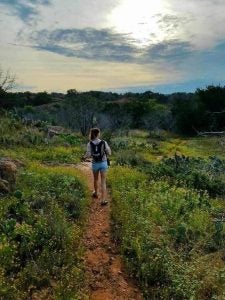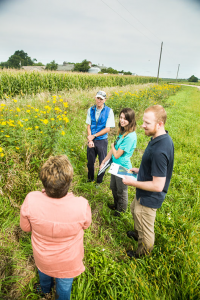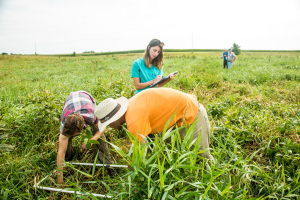
Now living in Austin, Texas where diverse wildlands are numerous and easily accessible, Audrey takes any opportunity she can get to put on her hiking boots and explore her natural surroundings. She also volunteers with the City of Austin to give guided hikes on preserves. Credit: Rob Binder
I grew up in the high and dry panhandle plains of Texas, where trees are scarce, wind is always blowing, and the smell of feedlots lingers in the air. Needless to say, I was not overly inspired by my surroundings – at least not at the time I lived there.
Had I not traveled with my family growing up, I wouldn’t have known what I was missing. Throughout these travels, I became enraptured by the biodiversity and lushness of other ecosystems and felt compelled to learn as much as I could about them.
But the stark contrast between some of the natural ecosystems and working landscapes I was exposed to led me to develop a pretty pessimistic view of humans’ impact on the environment. Surely, there had to be a better way of balancing human needs for things like food, water and shelter with nature’s needs.
Determined to tackle this problem, I got my Master’s in Environmental Management from Duke University’s Nicholas School of the Environment and took a job at Environmental Defense Fund (EDF), where I had heard that scientists and economists were developing incentive programs for landowners to improve water quality, reduce greenhouse gas emissions and restore habitat for at-risk wildlife.
Little did I know my worldview was about to be turned upside down.
Putting people first
I have been surprised in my first year at EDF by how many people have a stake in the conservation game – some of the same people I previously assumed were part of the problem. There are farmers, ranchers, food companies, transportation executives, academics and practitioners all in search of the same thing I am – balance. In this case, it’s balance for the monarch butterfly, which everyone can see is rapidly declining and needs help, fast.

Audrey and her colleagues meet with Minnesota farmer Kristin Duncanson to learn why she is interested in conserving monarch butterfly habitat and what incentives would help other farmers do the same.
Everyone comes to the table from different vantage points with different goals, so we’re working to design a program that meets these various goals. My study of natural sciences has helped me engage with the academics and practitioners who are helping to develop a science-based tool for assessing monarch habitat, but I have found myself becoming more and more invested in human sciences to understand how to translate this science into action. For that, I need to understand the needs and values of the people who will provide the supply and demand for monarch conservation. What would make the farmers want to plant milkweed? What would make the food companies want to invest?
The monarch butterfly is an interesting case study, because it’s about so much more than financial incentives. Landowners and investors are still people, and the monarch butterfly is a species that a lot of people care about.
Understanding nature can only get us so far when it comes to figuring out sustainable solutions. Understanding people gets us the rest of the way.
The missing piece
I may have become an optimist about human’s role in protecting nature, but I am not ignorant to the shortcomings of current conservation design.
The current lack of tracking restoration efforts and reporting outcomes is a huge disservice to the conservation industry. It’s one of the reasons why the politics of conservation have become so fraught. What has all of our federal spending on conservation programs bought us? We can’t expect the public or private sector to be willing to invest if we have nothing to show for it.

Audrey and her colleagues apply the monarch butterfly Habitat Quantification Tool to assess monarch habitat quality on a Minnesota farm.
It’s time we take conservation to the next level with advanced accounting tools that can deliver the most conservation per dollar invested, and report back to investors to show precisely how we have moved the needle.
We’ve been developing a tool to do this for the monarch butterfly to keep us on track and accountable as we develop a program to bring solutions to scale before the June 2019 deadline for the butterfly’s status check under the Endangered Species Act. This status check will depend on exactly this kind of accounting data.
We must be able to show what our investments will get us, or we will lose the policies and mechanisms that drive conservation in America. Both people and nature depend on it.
Related:
Farmers and environmentalists want the same thing >>
Three threats to the monarch butterfly’s winter habitat and what we can do about it >>
As winter approaches, monarch caterpillars fuel up on a Minnesota farm >>










2 Comments
Very informative article on the conservation efforts .
Thank you for sharing.
Cities should look into joining MONARCH CITY USA. Check them out.